
A pair of new, mighty Sunn 100S amps—the company’s original flagship amplifier—built by the new team led by James Lebihan, Mike Eldred, and Steve Skillings.
Since forming to help early garage rockers the Kingsmen bring their hit “Louie Louie” on the road, Sunn amps have roared behind everyone from Jimi Hendrix to Leslie West to Kurt Cobain to the doom-metal act that bears their name. After laying dormant for decades, the brand is back and the new team promises to live up to its legendary reputation.
“Have you ever considered covering ‘Louie Louie,’” I ask Stephen O’Malley over Zoom. The doom-metal guitarist and half of the band Sunn O))) is a native of Seattle but has lived the past 20 years in Paris, France. “I see where you’re going with this,” O'Malley chuckles, and says, “but we’re not a rock ’n’ roll band. Still, the Kingsmen and Conrad Sundholm building a bass amp for his brother—that’s a legendary Northwest story.”
In 1963, the Portland, Oregon-based Kingsmen found themselves near the very top of the charts behind what would become a garage-rock standard, the immortal “Louie Louie.” The Kingsmen’s bass player, Norman “Norm” Sundholm, and his brother, Conrad Sundholm, simultaneously became seminal figures in developing an amplifier line that would eventually become the sonic foundation of the doom-metal music artists like Stephen O’Malley play. In between, the amps became a crucial sound in classic rock.
The Kingsmen’s version of “Louie Louie” [written by Richard Berry] sat in the Billboard Hot 100 chart for 18 weeks, peaking at number two. Suddenly, everyone wanted to see the band live, and they hit the road, playing on stages all over the country. PA systems geared toward high fidelity for rock ’n’ roll concerts were still several years away, and Norm Sundholm needed a bass amp that could stand up to the rigors of the road and be loud and clear enough for the concert halls and gymnasiums hosting the Kingsmen.
Norm’s brother, Conrad, was a high school physics teacher and an electronics wizard. The siblings rolled up their sleeves together to build a bass amp for the Kingsmen’s first big tour. According to an interview Norm gave to NAMM in 2019, they first modified a 26-watt Fender Bandmaster, replacing the speakers with JBLs and adding a preamp stage using an off-the-shelf amplifier manufactured by Dynaco. Using their surname as inspiration, they called the 60-watt amp a Sunn.
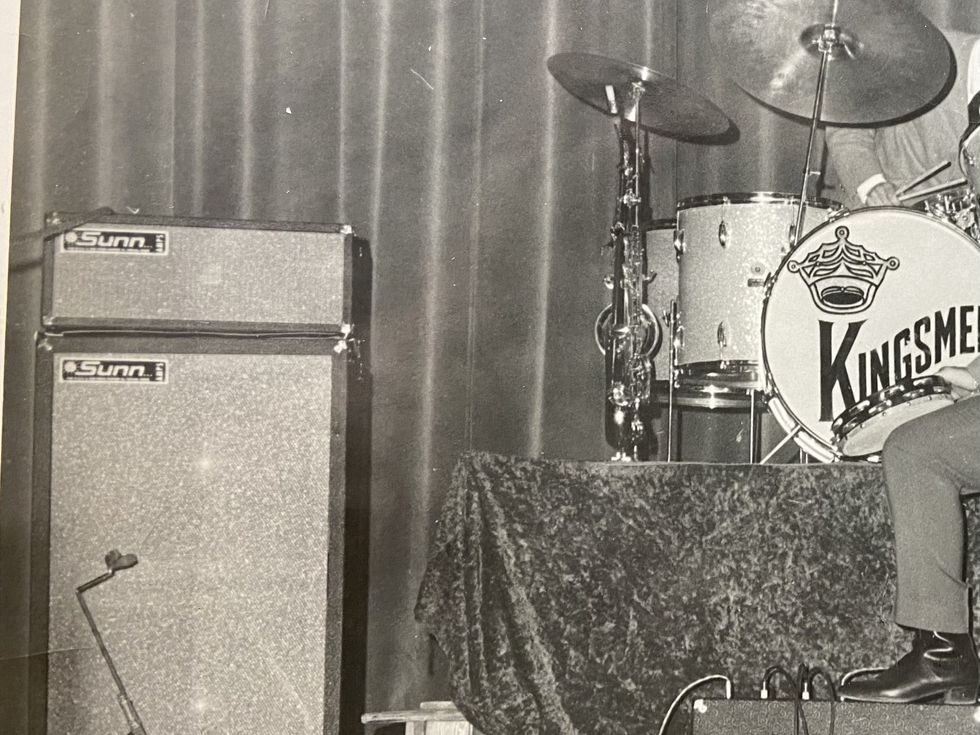
Hot on the heels of their hit single “Louie Louie,” the Kingsmen needed more amp power. Bassist Norm Sundholm turned to his brother Conrad, who started the Sunn brand with this early model.
Photo from the collection of Bill Eberline
Norm Sundholm declined to be interviewed for this piece, and Conrad Sundholm died in 2021, but his son, Steve Sundholm,fills in what came next: “Uncle Norm gave out my dad’s number to fans at Kingsmen shows who heard this amp and wanted to buy one. So my dad started getting random calls from people around the country asking how they could purchase a Sunn amp.” By about 1965, Conrad borrowed $1,300 from his credit union to begin building speaker cabinets and cobbling together new Sunn amps. Partly using Dynaco components and employing JBL speakers, early models included the 100S for guitar and the 200S for bass. Throughout 1963 and 1964, Conrad Sundholm built Sunn amps in his garage.
During downtime from Kingsmen tours, Norm went on the road in search of retailers to carry the Sunn line. While on tour, he met Bill Eberline, an 18-year-old disc jockey from Michigan, and hired him to be the company’s first sales rep. Eberline worked in 18 states east of the Mississippi, setting up retailers. Now 79 years old, Eberline tells me, “For me, Sunn was a passion, and the reason it was a passion was because the amps and the cabinets were so good. I loved the look on a musician's face when they plugged in for the first time and turned it up.” The secret, he says, was not only the amplifiers’ power and tone, but also the unique design of the speaker cabinets.
“The speaker cabinets for our bass amp, the 200S, were called rear-loaded, folded-horn, bass-reflex enclosures,” he explains. “So the speaker comes in from the back, there’s baffling inside, and the speaker is tuned to the cabinet. So you get the most out of it; you’re getting as much sound off the back as you’re getting off the front. I used to demonstrate it to people using a match. I’d put a lit match in front of the speaker, and it would blow the match out. Other speakers had open backs, so you were losing all that sound. And it gave it an incredible punch. It was the best bass speaker cabinet, at the time, that had ever been built.”
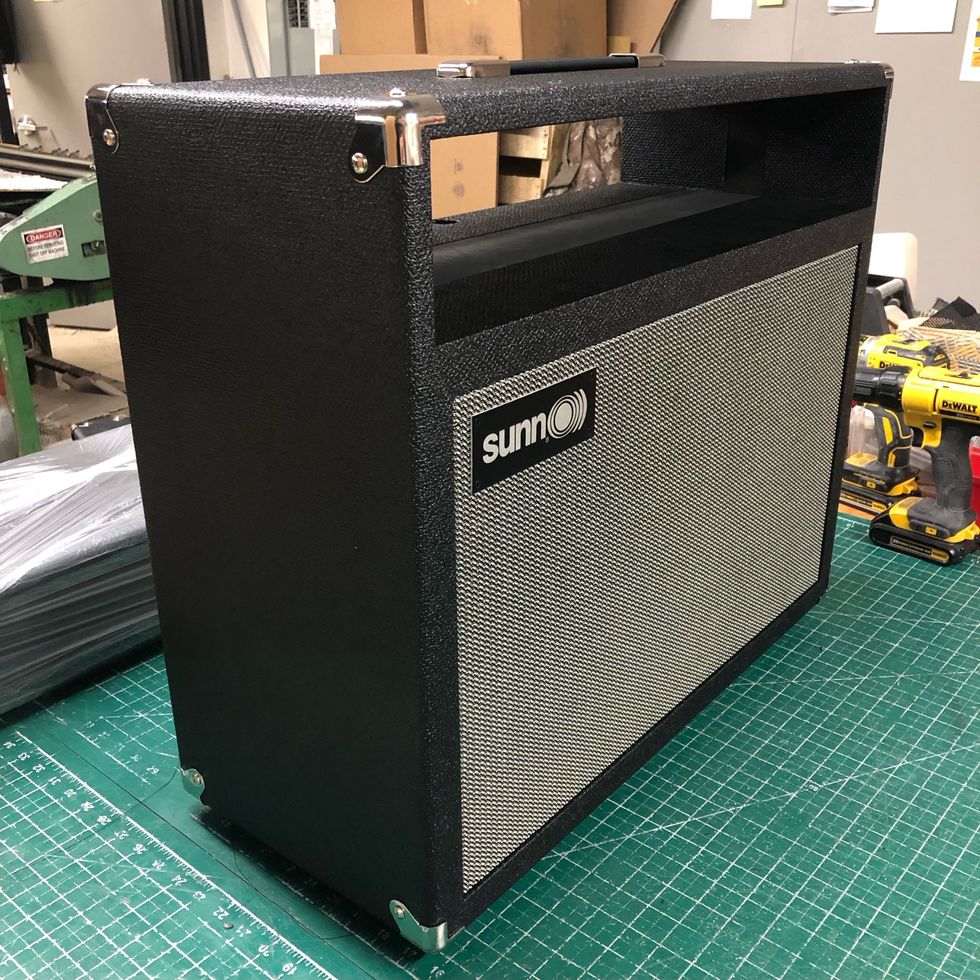
After sitting dormant for more than two decades, the Sunn brand has been resurrected by a new team that promises to stick to the company’s core construction techniques while addressing the needs of modern players. This cab is classic Sunn.
“We started going from music store to music store, unloaded them out of the van, and wheeled them into shops,” Norm Sundholm told NAMM. “It was a little tough with the franchise Fender dealers, but any competing store was wide open to take the line.”
It was Bill Eberline who brought one of Sunn’s biggest retailers to the party: Manny’s Music in New York City. Manny’s was the epicenter of Manhattan’s music retailers row on West 48th Street. About 10 different shops lined the block between 6th and 7th Avenues, making it simple to stumble from one to another. From Jimi Hendrix to Jimmy Page, all the premier guitarists of the day shopped there.
“I used to demonstrate it to people using a match. I’d put a lit match in front of the speaker, and it would blow the match out.” —Bill Eberline
“At first, Manny’s wasn’t interested,” Eberline recalls. “And Manny himself eventually kicked me out of the store; I was hanging out there all day with this big amplifier. But as I was leaving, one of his competitors across the street saw me and the amp, and he called me over. He said to me, ‘Listen, kid. [Eberline was 20 years old at the time.] Have your factory ship me a bunch of empty boxes with the Sunn logo.’ And I did! He put these out on the street in front of his shop like they were trash, as if he had ordered a bunch of our amps.” Soon after seeing the boxes, Manny’s placed an $80,000 order. That huge sale, in 1965, gave Sunn enough capital to move into a bigger manufacturing space, which Steve Sundholm tells me was his grandfather’s garage. “It was big, like the size of a boathouse,” he says.
Inside the garage, Sunn built tube guitar and bass amps such as the 60-watt 100S and 200S, and the 120-watt 1000S and 2000S, as well as the solid-state 100-watt Beta series and the 300-watt (at 2 ohms) Coliseum. The amps quickly became known for their volume, punch, and ability to deliver an articulate bottom end, and they became increasingly more visible on high-profile stages. Noel Redding, playing bass in the Jimi Hendrix Experience, used six Sunn speaker cabinets and three amp heads in June 1967 at the Monterey Pop Festival. Sunn amps were also seen and heard in the backlines of Led Zeppelin, the Who, and Cream. Hendrix most likely purchased his Sunn gear at Manny’s Music. Eberline remembers, “Jimi played through two of our most powerful amps daisy-chained together—the 1000S, double the power of the regular [100S] amp, and it used four KT88 tubes. He put that through four Sunn cabinets with two 15-inch speakers in each cab.”
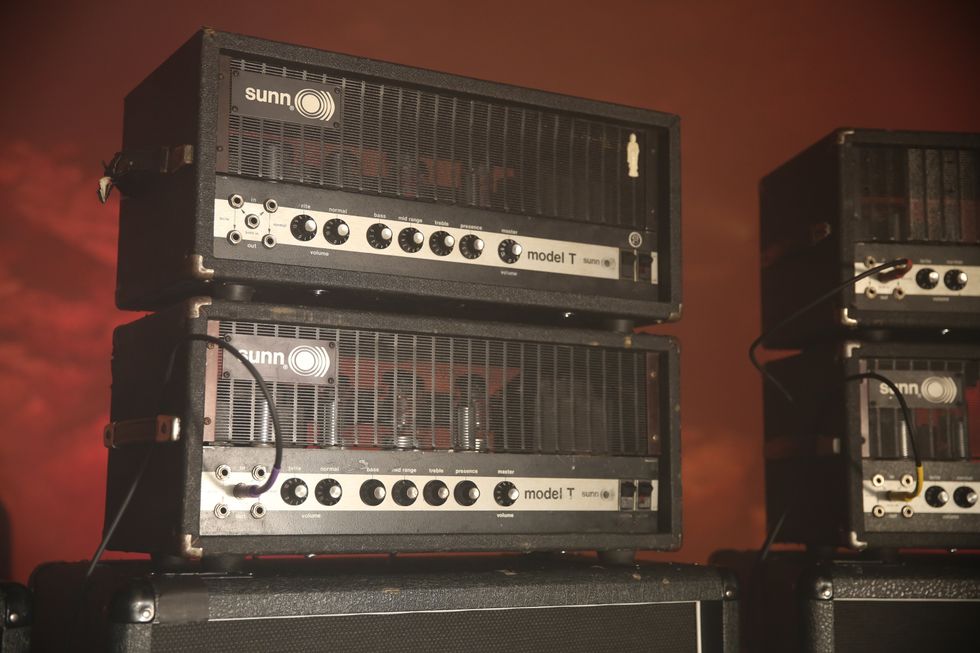
The Model T, one of the most coveted amps to bear the Sunn name, was created during Tom Hartzell’s ownership of the company. This is one of the many employed by Sunn O))) guitarists Stephen O’Malley and Greg Anderson.
Photo by Chris Kies
In August 1969, Eberline trucked Sunn amps to Woodstock, where they appeared behind Felix Pappalardi and Leslie West of Mountain on their Saturday evening set. That got Eberline into trouble. The roadies at Woodstock kept all the loaned amps, Sunn lost the inventory, and Eberline was fired.
James Lebihan is the CEO of the newly relaunched Sunn brand. He takes the history further, telling me over Zoom, “Everybody used Sunn gear—the Beach Boys, the Allman Brothers, and the Jeff Beck Group. Even later, bands like Queen used Sunn amps.” The Rolling Stones considered endorsing Sunn amps. However, according to the book Rolling Stones Gear by Andy Babiuk and Greg Prevost, the Stones’ shipment of amps was damaged in transit, and the endorsement never materialized.
The common denominator for the bands embracing Sunn was the desire for an overdriven tone with a lot of bottom end. In other words, the sound was heavy. Their tone was perfect for early metal and hard-rock artists like Black Sabbath and Mountain. West used a Sunn speaker cabinet to record their iconic “Mississippi Queen” at the Record Plant in New York City.
In 1972, a few years after leaving their dad’s boathouse-size garage and opening a factory in Tualatin, Oregon, the Sundholm brothers sold their company to a manufacturer named Tom Hartzell. Although a few of Sunn’s best models emerged during that period—including the iconic, tube-driven, 150-watt Model T—the Hartzell years are considered by many to be somewhat lost. Eberline says, “I left before they sold the company, but those new guys did not know what they were doing, in my opinion.” Hartzell was not a music-business guy and didn’t quite grasp the industry’s economics. Then, in 1977, he perished in a plane crash.
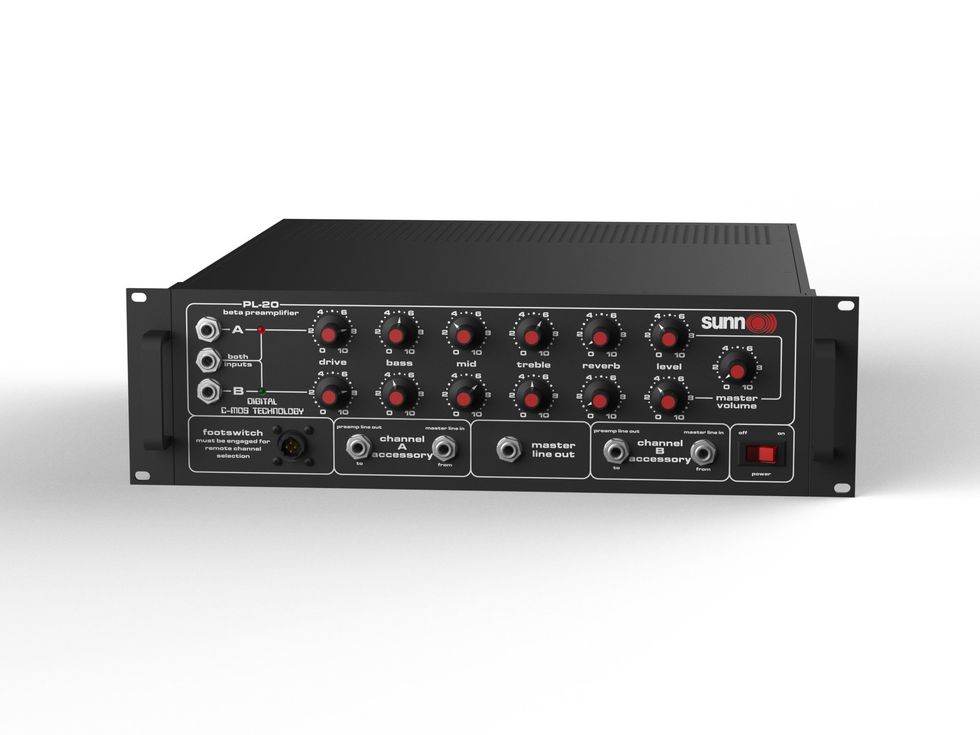
The magic of the Sunn Beta Lead and Bass amps was in their preamps. Here’s a current rackmount-ready version of that famed preamp unit, from the new Sunn factory.
Not much happened after Hartzell’s passing, and the brand lay dormant until Fender purchased Sunn in 1985, just as punk rock and metal split into genres, including hardcore, doom metal, and grunge. Sunn amps were embraced by guitarists like the Melvins’ Buzz Osborne and Nirvana’s Kurt Cobain. That’s when Stephen O’Malley first became aware of them. “I was into hardcore and death metal,” he remembers. “I was15 years old, and I saw the Melvins. They burst my brain open. Joe Preston is on bass, and Buzz Osborne is playing two full Sunn stacks with two Sunn Beta Leads. That was the first time I heard loud guitar where it was ripping the air apart, and you feel it in your body.” O’Malley also recalls seeing Northwest heavy rockers Karp using a Model T, and he praises that amp’s ability to be adapted to a genre like doom metal.
“We modify them,” he explains. “We put in special tubes, and we’re able to change the bias of the amps. We take out what we don’t need, like the line out, and we take out the circuit breaker and replace it with a fuse. The Model T allows me to have less breakup in the preamp section and more headroom. It becomes more about speaker distortion and power-tube overdrive than high-input gain.”
The essential, blue-ribbon quality of the Model T—even unmoded—is how it works with overdrive and fuzz effects. The extraordinary transparency and headroom of these amps allows the sonic character of these pedals to take on enormous, growling dimensions—so they become almost supernatural versions of themselves.
Was it only the tone driving these later Northwest-based bands toward Sunn Amps? Perhaps not. Sunn had long been an Oregon company, so there were a lot of cheap, used Sunn amps sitting around in guitar shops from Portland to Seattle. Lebihan explains it this way, “When these guys were getting started, and they were teenagers, and they were in school, and they didn’t have any money, they could find these Beta Leads and Model Ts in pawn shops.” Stephen O’Malley tells me that his partner in Sunn O))), Greg Anderson, found his first Model T at a swap meet in Seattle—a vinyl dealer left it sitting under a table of records.
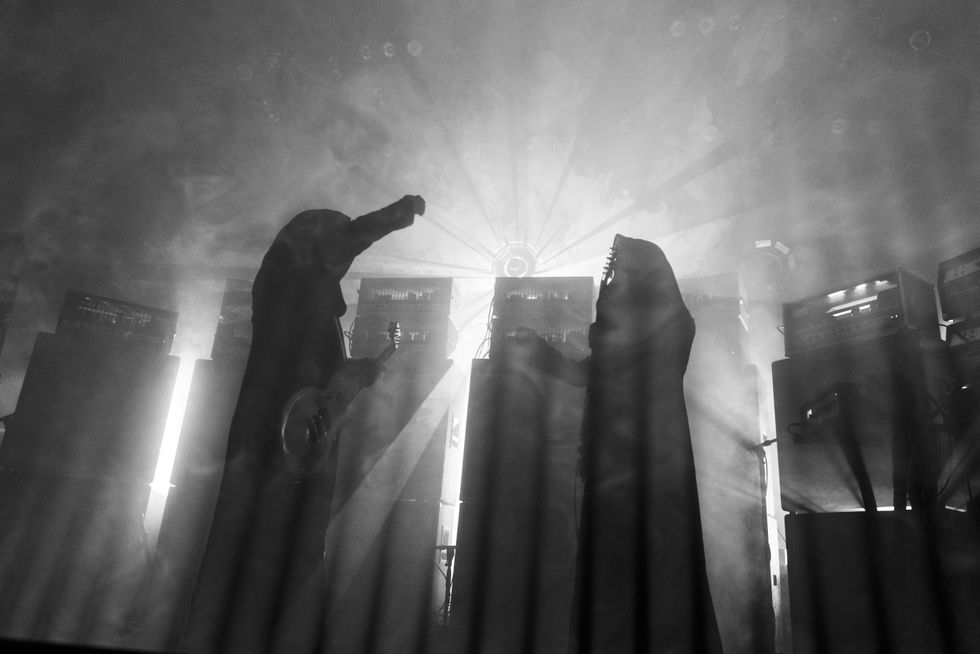
No band has taken the term “amp worship” more literally than Sunn O))), seen here leading service in front of a wall that consists mostly of Sunn amps.
Photo by Mike White
The steep headroom, high-gain, tube-driven 100S, 200S, Model T, and solid-state Beta line of bass and guitar heads are now considered the pinnacle of the original line. O’Malley claims some amount of credit for this: “They’re a mythical amplifier now, but I don’t know if they would be if it weren’t for our band and the scene around our band—like Wino Weinrich from the Obsessed, he played them, too.”
“I was 15 years old, and I saw the Melvins. They burst my brain open…. Buzz Osbourne is playing two full Sunn stacks with two Sunn Beta leads. That was the first time I heard loud guitar where it was ripping the air apart, and you feel it in your body.” —Stephen O’Malley
Until recently, Fender’s ownership would not be considered a new golden age for Sunn; not much happened. Fender did drop a Model T reissue, but that amp shared virtually none of the same circuitry as its Hartzell-era predecessor. Strangely, Fender actually built some electric guitars—using the Mustang and Strat names—overseas under the Sunn brand. But overall, the brand languished, making the vintage gear rare and sought-after in the used market.
Lebihan tells me that many have tried to get Fender to relaunch Sunn since the brand was discontinued in 2002. Still, it was only when he came to the table in 2023 and brought Mike Eldred and Steve Skillings with him that Fender executives finally sat up in their chairs and made a deal to relaunch Sunn. This triumvirate brings decades of musical marketing skills to the party: Lebihan had a background in tech before becoming a serial entrepreneur in the music world; Eldred was on the team that put the Fender Custom Shop on the map in the mid ’90s; and Skillings came from a background at Bose, where, among other things, he was on the Bose L1 team—the group that created the ubiquitous skinny-speaker PA systems popular with buskers, garage jammers, and wedding bands.
Together, this team has big plans for Sunn, and early on they ran a Wefunder campaign in which 288 enthusiasts were able to support the new Sunn company in exchange for discounts on amps and branded swag like t-shirts and pint glasses. The cash, says Skillings, is fueling costs for tooling and other early manufacturing requirements. “There’s a lot of costs associated with ramping up this kind of product,” he notes. “Just to do a mold for a knob, for example, costs $5,000.”
“There are cheaper ways to manufacture these things that would make it ‘not Sunn.’ And I see them going out of their way to recreate it as faithfully as possible without making it the cost of a mortgage payment to the customer.” —Steve Sundholm
And they’re preparing to drop new generations of amps in the near future. Not only will Sunn’s popular tube amps be back, but they’re also creating solid-state bass heads and new cabinets. And they plan to push well beyond what Sunn has been known for for 60 years. Mike Eldred is visibly excited when he says, “We’ve got a Beta combo amp coming up for preorder very soon. And we’re going to continue pushing into the combo market and beyond. You have a lot of folks now who don’t want to lug around a heavy 150-watt amp and products are coming out now that reflect that, where your amp is on your pedalboard. We’re going to go after that market aggressively.”
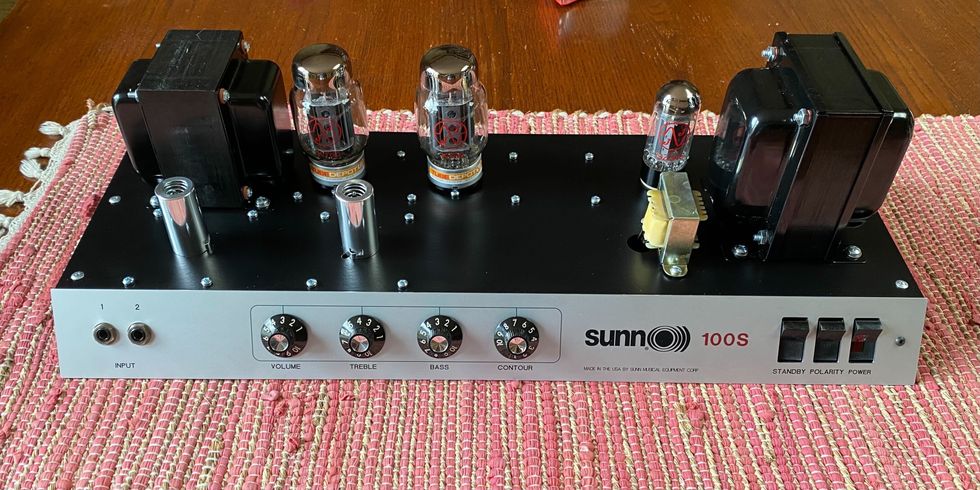
The essence of the modern Sunn 100S.
One thing everyone is curious about is the future of the Model T, the amp most heavily embraced by O’Malley, Anderson, and other doom-metal axe grinders. That’s something the new Sunn team is rethinking very carefully. The Model T offers a singular tone, but in today’s live music environment, where portability and low-wattage amps rule, it’s a bit of a dinosaur. Eldred says, “There’s no reason why you can’t take the tone stack of a Model T and pare it down into something like a 20-watt version of the amp.”
Steve Sundholm became a board member of the new Sunn brand after his dad passed away. He tells me that at the end of his dad’s life, Conrad knew Sunn was coming back. “He told me, ‘Man, I hope they do it right.’ Not ‘They better do it right,’ just ‘I hope they do.’” Steve is convinced that his dad would be proud of this relaunch. “I’ve seen their plans,” he says, “and I really feel like they are going above and beyond to do it right. For example, they’re building the same closed-back cabinet style as the vintage speakers. There are cheaper ways to manufacture these things that would make it ‘not Sunn.’ And I see them going out of their way to recreate it as faithfully as possible without making it the cost of a mortgage payment to the customer.”
O’Malley, who considers the amps in his backline “members” of his group, also looks forward to checking out the upcoming line and what the new Sunn team is doing. He says, “I understand that they are building the new amps to original specs; I’m really curious about them.” Even still, a “Louie Louie” cover from Sunn O))) to connect the dots probably won’t materialize.
There’s no doom-metal band out there I can find who’s covered the Kingsmen’s signature tune, although both Motörhead and Black Flag have taken great, heavy shots at it. Perhaps they may have even used Sunn amps in the process. As Sunn rises again, illuminating the musical landscape once more, the chance for new riffs and powerful sounds to come from this brand is brighter than ever.
- Turning Your Amp On ›
- Tone Tips: Dialing in Your Gear for Great Sound ›
- Ask Amp Man: Removing Output Tubes to Reduce Power ›
Guest picker Mei Semones joins reader Jin J X and PGstaff in delving into the backgrounds behind their picking styles.
Question: What picking style have you devoted yourself to the most, and why does it work for you?
Guest Picker - Mei Semones

Mei’s latest album, Kabutomushi.
A: The picking style I’ve practiced the most is alternate picking, but the picking style I usually end up using is economy picking. Alternate feels like a dependable way to achieve evenness when practicing scales and arpeggios, but when really playing, it doesn’t make sense to articulate every note in that way, and obviously it’s not always the fastest.
Obsession: My current music-related obsession is my guitar, my PRS McCarty 594 Hollowbody II. I think it will always be an obsession for me. It’s so comfortable and light, has a lovely, warm, dynamic tone, and helps me play faster and cleaner. This guitar feels like my best friend and soulmate.
Reader of the Month - Jin J X
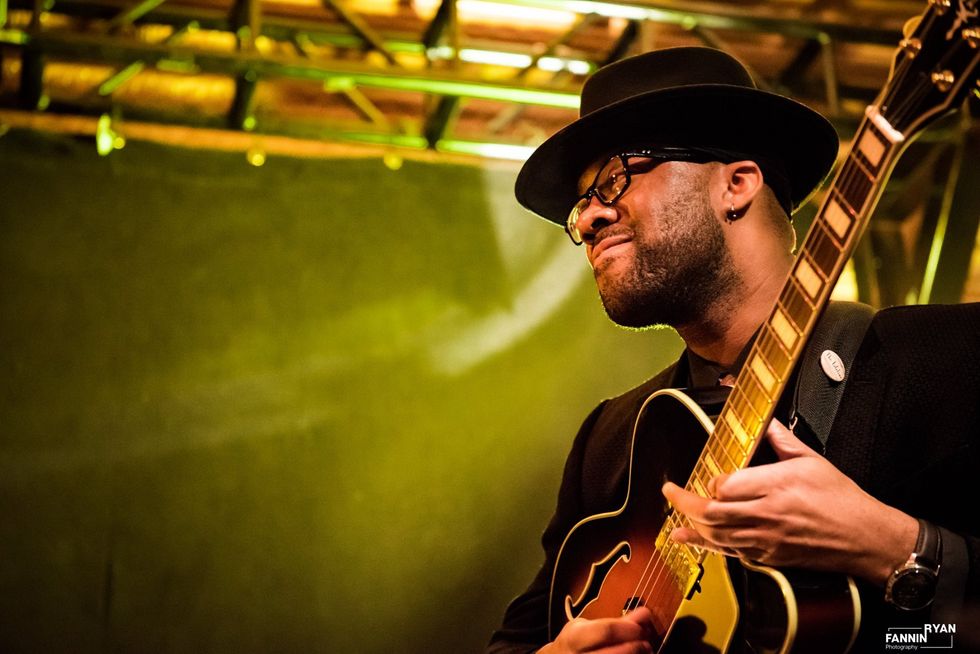
Photo by Ryan Fannin
A: For decades, the Eric Johnson-style “hybrid picking” with a Jazz III for “pianistic” voicings. Great for electric, though not so much acoustic. I’ve been recently learning to use a flatpick, à la Brian Sutton, by driving the pick “into” the string at an angle—which makes me think of Pat Metheny and George Benson, without irony.
Obsession: I’m still focused on understanding the concepts of jazz, neo-classical, and beyond, though I’m also becoming obsessed with George Van Eps’ 7-string playing, flatpicking, hip-hop beats, the Hybrid Guitars Universal 6 guitar, and the secret life of the banjo.
Editorial Director - Ted Drozdowski

A: Decades ago, under the sway of Mississippi blues artists R.L. Burnside, Junior Kimbrough, and Jessie Mae Hemphill, I switched from plectrum to fingerstyle, developing my own non-traditional approach. It’s technically wrong, but watching R.L., in particular, freestyle, I learned there is no such thing as wrong if it works.
Obsession: Busting out of my songwriting patterns. With my band Coyote Motel, and earlier groups, I’ve always encouraged my talented bandmates to play what they want in context, but brought in complete, mapped-out songs. Now, I’m bringing in sketches and we’re jamming and hammering out the arrangements and melodies together. It takes more time, but feels rewarding and fun, and is opening new territory for me.
Managing Editor - Kate Koenig
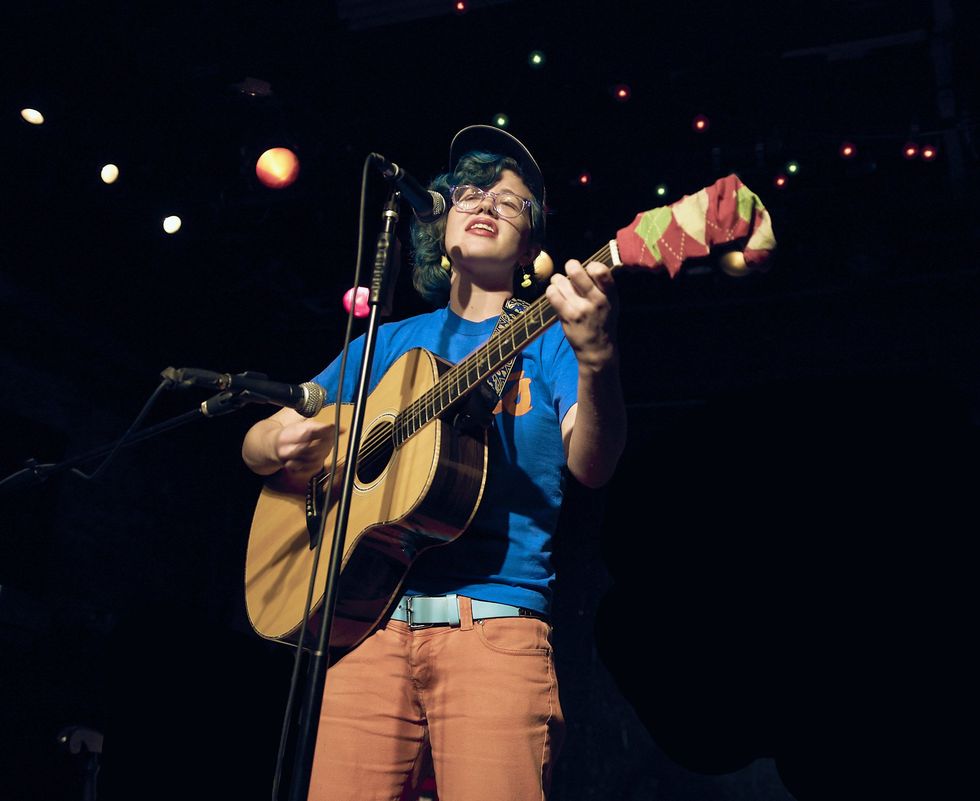
A: I have always been drawn to fingerpicking on acoustic guitar, starting with classical music and prog-rock pieces (“Mood for a Day” by Steve Howe), and moving on to ’70s baroque-folk styles, basic Travis picking, and songs like “Back to the Old House” by the Smiths. I love the intricacy of those styles, and the challenge of learning to play different rhythms across different fingers at the same time. This is definitely influenced by my classical training on piano, which came before guitar.
Obsession: Writing and producing my fifth and sixth albums. My fifth album, Creature Comforts, was recorded over the past couple months, and features a bunch of songs I wrote in 2022 that I had previously sworn to never record or release. Turns out, upon revisiting, they’re not half bad! While that one’s being wrapped, I’m trying to get music written for my sixth, for which I already have four songs done. And yes, this is a flex. 💪😎
Guitarist, songwriter and bandleader Grace Bowers will independently release her highly anticipated debut album, Wine On Venus, August 9.
The new album adds to a breakout year for Bowers, who was recently selected as a U.S. Global Music Ambassador as part of the U.S Department of State and YouTube’s Global Music Diplomacy Initiative, is nominated for Instrumentalist of the Year at the 2024 Americana Music Association Honors & Awards and will make her debut performance on the legendary Grand Ole Opry on her eighteenth birthday, July 30, 2024. Other performances this year include shows supporting Slash, The Red Clay Strays and Brothers Osborne as well as stops at Levitate Music & Arts Festival, Floyd Fest, Bristol Rhythm & Roots Reunion, Bourbon & Beyond, XPoNential Music Festival and Pilgrimage Music & Cultural Festival. See below for complete tour itinerary.
Grace Bowers & The Hodge Podge - Tell Me Why U Do That (Official Video)
Produced by John Osborne (Brothers Osborne), Wine On Venus captures the electric energy of Bowers’ live performances with The Hodge Podge. The record consists of nine soul-infused tracks including a new version of Sly and the Family Stone’s “Dance to the Music” as well as previously release single, “Tell Me Why U Do That,” of which Forbes praises, “an infectious, joyous party and a worthy introduction to Bowers.” Additionally, The Bluegrass Situation declares, “an exceptional breakout talent who seems primed for a long career to come,” while RIFF Magazine calls her “The next generation’s star of American rock, blues and funk guitar.”
Of the record, Bowers shares, “I’m so excited to share my first album with the world in August! It’s been a long time coming, and I’m proud of what was created with the incredible Hodge Podge and John Osborne producing. We recorded everything live, as it should be, for this sonic journey. I hope you love it as much as I do.”
Additionally, of the title track, she reflects, “My nana was 100 years old when she passed away last year. She would always tell me that when she died, she would be drinking wine on Venus. She was a little eccentric but thought that was just something so cool. When she passed, I wrote a song about it.”
In addition to Bowers (guitar), the record features Joshua Blaylock (keys), Brandon Combs (drums), Eric Fortaleza (bass), Esther Okai-Tetteh (vocals) and Prince Parker (guitar) as well as songwriting collaborations with respected artists such as Ben Chapman, Meg McRee, Maggie Rose and Lucie Silvas.
Originally from the Bay Area and now calling Nashville home, Bowers began garnering attention after sharing videos of herself playing guitar on social media during the pandemic. In the years since, she’s been featured on “CBS Mornings” in a piece focused on a new wave of young female guitarists, performed alongside Dolly Parton as part of her Pet Gala special on CBS, joined Lainey Wilson as part of CBS’ New Year’s Eve Live celebration, performed as part of the “Men’s Final Four Tip-Off Tailgate Presented by Nissan” and been sought after by everyone from Devon Allman to Tyler Childers and Susan Tedeshi to Kingfish. Of her 2023 Newport Folk Festival debut, Rolling Stone declared, “Her 20-minute performance gave the distinct sense that everyone lucky enough to have attended was witnessing a star in the making,” while The Tennessean calls her “a 17 year old Blues guitar prodigy,” with a, “heart as big as her talent is vast.”
Most recently this summer, Bowers performed alongside Billy Idol at the Fired Up For Summer benefit concert and raised $30,000 for MusiCares and Voices for a Safer Tennesseewith her 2nd Annual “Grace Bowers & Friends: An Evening Supporting Love, Life & Music” benefit show. With the release of Wine On Venus (distributed by The Orchard), Bowers will further establish herself as one of music’s most intriguing new artists.
For more information, please visit gracebowers.com.
The new destination on Reverb will feature an always-changing collection of new and like-new music gear from top brands for at least 20% off retail prices.
“Outlet music gear is a fantastic value for music makers. Often, it’s brand new overstock or clearance music gear that retailers or brands are simply looking to clear out. Other times, it’s gear that’s been opened, used for a demo, or simply doesn’t have its original box, but is otherwise in like-new condition,” said Jim Tuerk, Reverb’s Director of Business Development. “With the launch of the Reverb Outlet, we’re making it easy to access your favorite brands for less.”
The Reverb Outlet will feature high-quality discounted music gear from Reverb’s community of authorized sellers, ranging from retailers like ProAudioStar and Alto Music to brands like Focusrite and Korg selling discounted items directly to music makers. All of the new and like-new music gear in The Reverb Outlet:
- Is at least 20% off retail prices—but often more
- Is sold by authorized retailers and brands
- Comes with free shipping, and
- Has a minimum 7-day return window.
“With economic pressures making it harder for music makers to invest in music gear, it’s more important than ever that the music-making community has access to affordable musical instruments. We launched the Reverb Outlet to make it easier for music makers to find the best deals on the instruments that will inspire them,” said Reverb CEO David Mandelbrot. “Now that players can shop discounted outlet music gear alongside our huge range of affordable used music gear, it’s easier than ever to find the perfect instrument for your budget.”
Visit the Reverb Outlet today and check back often, as new deals will be added regularly. Please note that as of now, this is available to those in the US only.
For more information, please visit reverb.com.
Introducing the limited-edition HALO Core by Keeley Electronics, with only 300 units available.
Andy Timmons’ mysterious-sounding “Halo” effect is a modulated dual echo sound that has long been kept a secret by the tone wizard himself. Andy spent decades combining and crafting the sounds you can now get from the HALO Core.
Notes from the HALO Core dance rhythmically, almost creating a reverb diffusion. Those notes are held together with tape-style effects like modulation, saturation, and compression. The results are stunning.
Discover the latest from Keeley Electronics: the HALO Core, a streamlined version of our top-sellingHALO Andy Timmons Dual Echo. The HALO Core delivers Andy's iconic ‘HALO’ sound and includes a 1/4 Note Mode, offering all the essential features without any unnecessary extras.
Key Features
- True Stereo Input and Output: Enjoy immersive sound quality with true stereo capabilities.
- Switchable Trails or True Bypass: Easily switch between trails or true bypass operation on the fly to suit your playing style.
- All-Wet or All-Dry Modes: The HALO Core is engineered to work perfectly with straight-into-amp and effects loop setups.
- Tap Tempo Footswitch: Achieve perfect timing with the new dedicated Tap Tempo footswitch.
- Redesigned ‘Infinite Hold’ Feature: Experience enhanced sound with our improved Infinite Hold feature
- Intuitive Alt Controls: Fine-tune your sound with adjustable High Pass Filter, Delay Tone, and tape-like Saturation controls.
The HALO Core is the ideal grab-and-go, studio-grade delay pedal, offering professional quality in an easy-to-use format. Elevate your music with Keeley Electronics' HALO Core.
Use the Saturate control to add tape compression texture to your tone. The Tone and High Pass Filter controls your overall delay shape and mix. Set the Time and Feedback controls low, and you can open up a world of ambient chorus and flanger effects. Run the HALO in stereo for incredible true-stereo imaging.
MSRP $199.00
For more information, please visit robertkeeley.com.


